Documentation/HowTo/Draw/Fontwork
TDF LibreOffice Document Liberation Project Community Blogs Weblate Nextcloud Redmine Ask LibreOffice Donate
What is the Fontwork tool?
See this FAQ entry.
How do I create a Fontwork object?
See this FAQ entry.
How do I modify a Fontwork object?
Selecting a Fontwork object
A click with the left mouse button on a Fontwork object allows you to select it.
A selected Fontwork object is surrounded by seven blue squares, called "handles", which allow it to be resized and a yellow dot. The latter allows the letters composing the object to be dragged:
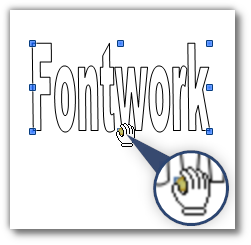
Using the Fontwork Toolbar
You have created a Fontwork object, and you want to change some of its attributes.
To do this, you will use the Fontwork toolbar.
Make sure the Fontwork toolbar (shown in figure 1) is visible.
If it is not present, select the ▸ ▸ menu.
The various tools will allow you to easily and quickly modify your Fontwork objects.
![]() Fontwork Shape Allows you to modify the shape of the object selected among the styles proposed by the palette of different shapes (Figure 1):
Fontwork Shape Allows you to modify the shape of the object selected among the styles proposed by the palette of different shapes (Figure 1):
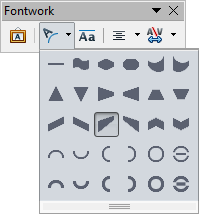
![]() Identical height for Fontwork letters Changes the height of characters in the object.
Identical height for Fontwork letters Changes the height of characters in the object.
Toggles between normal letter height and all letters of the same height (some characters are larger than others, e.g. upper case, or some lower case such as f, h, l, etc.):

![]() Alignment Allows you to change the character alignment:
Alignment Allows you to change the character alignment:
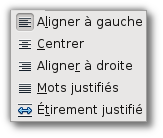
You can therefore in order: Align Left, Center, Align Right, and Justify Text.
Note: The effects of text alignment are only visible if the object has two or more lines.
With the last option of the Alignment sub-menu, click on the entry ![]() , so that each line of the Fontwork object will be filled completely as shown in the figure below:
, so that each line of the Fontwork object will be filled completely as shown in the figure below:

Tip: To make a multi-line Fontwork object, press ↵ Enter for each desired line break as shown below:

![]() Character spacing Allows you to change the spacing and kerning of characters:
Character spacing Allows you to change the spacing and kerning of characters:
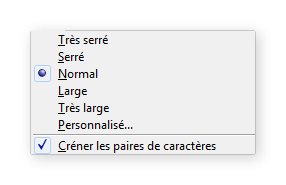
Select the desired spacing and whether kerning pairs are used. For custom spacing, enter a percentage value: 100% is the normal percentage; below 100% is narrow spacing, above 100% is wide spacing.
Note : The kerning or approach adjustment allows for subdivisions and spacing.
This operation consists of reducing or increasing the spacing between letters in order to harmonise the appearance of the handwriting, for example for the letters W and a.
The kerning tables contain information indicating which pairs of letters require greater spacing.
These tables are usually embedded in fonts.
Using the toolbar Drawing object properties
With Writer, for example, if you click on an existing Fontwork object, the Drawing Object Properties toolbar replaces the Formatting toolbar to display the Fontwork options.
The content of this toolbar may vary depending on the LibreOffice module used.

Using this toolbar, you will be able to access advanced functions for customising your Fontwork object.
- Click on a Fontwork shape. The toolbar ' Drawing object properties changes, displaying the characteristics of this object, and thus offering many alternatives for its edition (in particular if you use Fontwork in the Writer module).
- On the toolbar Drawing object properties you have a whole range of tools for the personalization of your object.
Note : All these options are the same as for other Draw drawing objects.
Line options
![]() Line Tool Opens a dialog with three tabs:
Line Tool Opens a dialog with three tabs:
Line, Line Styles, and Arrow Styles (Figure 4).
- Use the Line tab to modify the most common properties of the line surrounding each letter of the selected Fontwork object, by choosing from the default styles, including line style, colour, width and transparency.

- Use the Line Style tab to modify the existing line styles or create new ones which will then be available in the Line Style drop-down menu of the Line tab.
Note : The Arrow Styles tab will not be discussed here as it is not relevant to a Fontwork shape.
Attention : Only assign line properties to Fontwork objects that don´t have 3D effects, as changes will not be visible. !
Line style : ![]() Choose from the available line styles.
Choose from the available line styles.
Line colour : ![]() Choose the colour of the line.
Choose the colour of the line.
Line width : ![]() Set the width of the line.
Set the width of the line.
Line transparency : ![]() Define the degree of transparency of the line.
Define the degree of transparency of the line.
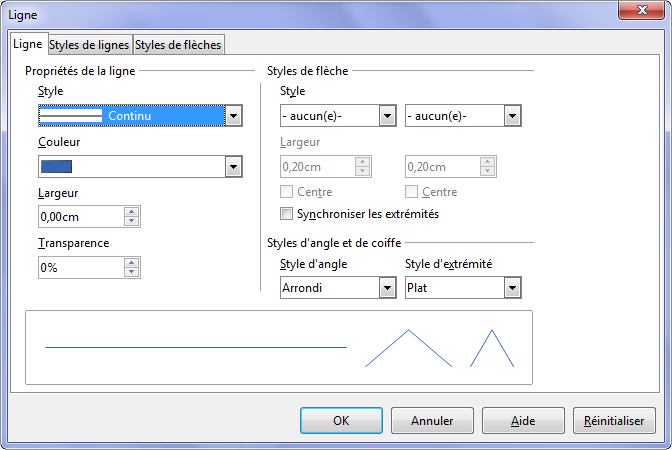
Filling options
![]() Filling tool Opens a dialog with seven tabs: Fill, Shadow, Transparency, Colors, Gradients, Hatching, and Bitmaps (Figure 5).
Filling tool Opens a dialog with seven tabs: Fill, Shadow, Transparency, Colors, Gradients, Hatching, and Bitmaps (Figure 5).
These options allow you to fill in each letter of the Fontwork object.
Here are some examples of filling with a defined colour, a drop shadow, a degree of transparency, a bitmap, and a colour gradient respectively:
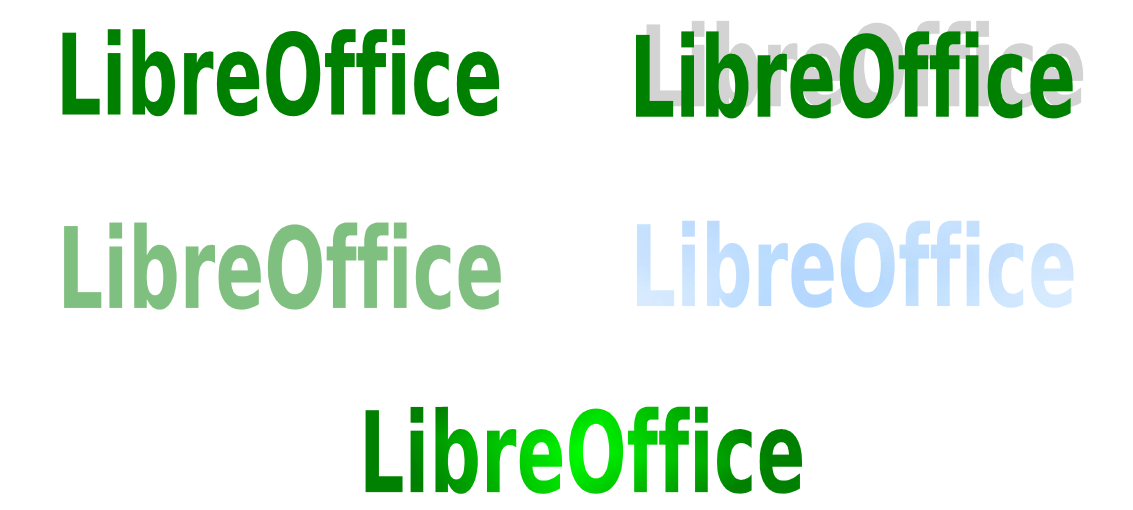
- Fill Tab: Choose from the drop-down list a colour, a gradient, hatching or a bitmap texture to fill each letter of the selected object.
- 'Shadow Tab: Click on the check box Apply shadow, and adjust the parameters such as distance, colour and transparency to bring to the shadow of the object.
- 'Transparency Tab: Define a degree of transparency to bring to the selected object.
- Colours tab: Modify the available colours or add new ones to the palette. These colours will then be available in the drop-down list of the Fill tab.
- Gradients Tab: Modify the available gradients or add new ones without forgetting to name them. These gradients will then be available in the drop-down list of the Fill tab.
- Hatch Tab: Modify the available hatching or add new ones without forgetting to name them. These hatchings will then be available in the drop-down list of the Fill tab.
- Bitmaps : Create simple bitmap patterns (textures) or import them, to make them available in the drop-down list of the Fill tab.
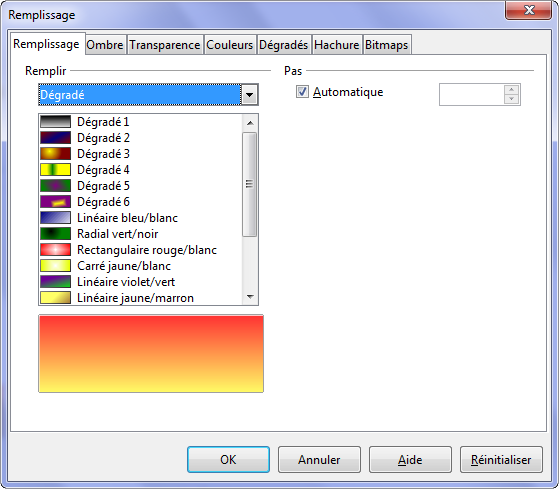
Note : The Line and Fill tools are also accessible from the Line and Fill toolbar.
Fontwork object position options
![]() Rotate tool Allows you to manually rotate the selected object using the mouse.
Rotate tool Allows you to manually rotate the selected object using the mouse.
Use the red handles around the image and move the mouse in the direction you wish to rotate.
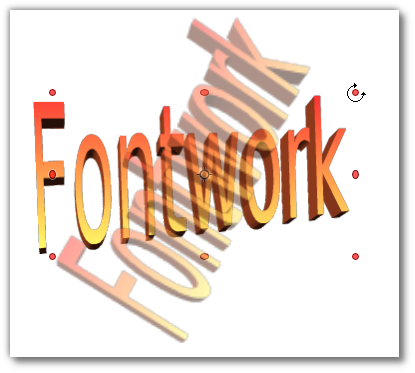
By default, the image is rotated around its centre (symbolised by a black test pattern), but you can change the pivot point by moving it to the desired centre of rotation.

![]() Arrange tool Allows you to arrange your graphic object to determine its vertical position relative to other graphic objects (rarely used for Fontwork objects) or text.
Arrange tool Allows you to arrange your graphic object to determine its vertical position relative to other graphic objects (rarely used for Fontwork objects) or text.
This tool has six icons:

- Send to the front: Places the selected object above any other image or text.
- 'Send forward: Places the selected object one level higher in the stack. Depending on the number of overlapping objects, it will be necessary to click several times on this icon to obtain the desired result.
- 'Send backwards: Moves the selected object one level lower in the stack of objects.
- 'Send to the back: Moves the object selected at the very bottom of the stack so that the other objects or the text covers it.
- 'In the foreground: Places the selected object in front of the text.
- 'In the background: Places the selected object behind the text.
![]() Modify Anchor Tool Allows you to change the object anchoring, allowing you to anchor Fontwork objects as a character or to a page, paragraph or character.
Modify Anchor Tool Allows you to change the object anchoring, allowing you to anchor Fontwork objects as a character or to a page, paragraph or character.
To the page : The object keeps the same position in relation to the margins of the page. It will not move even if you add or delete text or other objects such as images.
To the paragraph : The object is associated with a paragraph and moves with it. It can be placed in the margin or in another location.
To character : The object is associated with a character but is not a text sequence. It moves with the paragraph and can be placed in the margin or somewhere else (this method is similar to anchoring to the paragraph but cannot be used with drawing objects).
As character : The object is placed in the document like any other character affecting "text line height and line feed".
The object will move with the paragraph as you add or delete text before it.
![]() Grouping tool Allows you to group the selected objects, so that you can manage them as a single object (keyboard shortcut Ctrl + ⇧ Shift + G Draw and Print modules).
Grouping tool Allows you to group the selected objects, so that you can manage them as a single object (keyboard shortcut Ctrl + ⇧ Shift + G Draw and Print modules).
Note : This icon is only available (not grayed out) if the objects are previously selected with the combination of ⇧ Shift + click on each object.
![]() Ungroup tool Allows you to separate the selected objects, so that you can manage them individually (keyboard shortcut Ctrl + Alt + ⇧ Shift + G Draw and Print modules).
Ungroup tool Allows you to separate the selected objects, so that you can manage them individually (keyboard shortcut Ctrl + Alt + ⇧ Shift + G Draw and Print modules).
You can use some of the options seen in the previous sections from the menu to anchor, align, reflect horizontally and vertically, organize and group selected Fontwork objects.
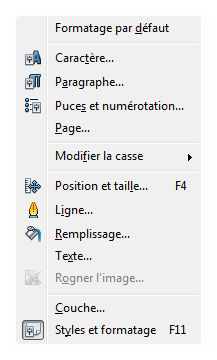
You can also right-click on a Fontwork object to get most of the options in a context menu.
Moreover, this contextual menu provides quick access to the tools , , , etc.
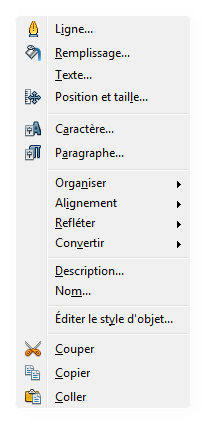
Note : The Text dialog offers only a few options for Fontwork objects and is not discussed here.
Instead, the context menu (as well as the menu) offers the entry ![]() or the keyboard shortcut F4. (Draw and Print modules) which opens the Position and size dialog allowing you to determine precise values for the size and position of the selected Fontwork object:
or the keyboard shortcut F4. (Draw and Print modules) which opens the Position and size dialog allowing you to determine precise values for the size and position of the selected Fontwork object:
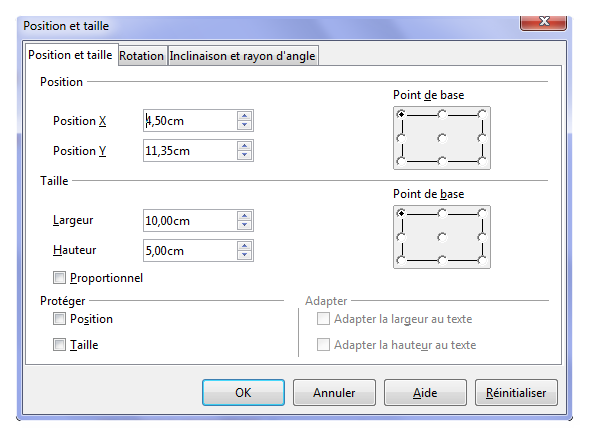
How do I resize and move a Fontwork object?
See this FAQ entry.